Time Axis Upgrades for OnePager 6.1
Contents
- 1 Introduction to the OnePager 6.1 Time Axis Upgrade
- 1.1 OnePager Time Axis Upgrade Overview
- 1.2 The New Template and Project-View Properties Time Axis Tab and Its Sub-Tabs
- 1.3 The Reorganized Template and Project-View Properties Main Tab
- 1.4 The Reorganized Template and Project-View Properties Advanced Tab
- 1.5 Globally Editing Project View Time Axis Levels and Cells
- 1.6 The New Non-Linear Time Axis Feature
- 1.7 The New Floating Time Axis Feature
- 1.8 Enhanced Manual Editing of Timespans (Time Axis Level Cells)
- 1.9 The New Custom Date Format Feature
- 1.10 Managing Working Hours and Non-Working Hours
- 1.11 Managing Inserted Curtains
- 1.12 Managing Timespans
- 1.13 Curtains, Timespans, and Snapshots
- 2 Links to Detailed Articles
- 3 Related Links
Introduction to the OnePager 6.1 Time Axis Upgrade
OnePager Pro and Express always provide a representation of the Time Axis with up to three levels that can appear at the top and bottom (optional) of the Graph.
OnePager Time Axis Upgrade Overview
1) The OnePager 6.1 Time Axis Upgrade provides:
- a) New Template and Project-View Properties (PVP) form tabs specifically for Time Axis global controls.
- b) Consolidated controls on the Template and PVP form’s Main tabs and Advanced tabs after Time Axis controls moved to the new Time Axis tabs.
- c) More graphic capabilities for tailoring Time Axis Levels and Cells with user defined variable text formats, background colors and fill patterns, variable Time Axis Level heights, and border formats properties.
- d) A capability for Re-ordering the positions of Time Axis Levels within the project view’s Time Axis areas.
- e) A new feature called the Non-Linear Time Axis that provides the capability to manually stretch or compress the width of Time Axis Level Cells on all Time Axis Levels and thereby use more or less horizontal space in the Graph to cover the same timespans.
- f) A Floating Time Axis feature and associated controls for you to place one, two, or three Time Axis Levels within the project view and edit its properties.
- g) Capabilities for you to define, edit, and use your own Custom Date Formats.
- h) Manual editing controls within the Graph for you to edit Time Axis Level and Cell format properties, Floating Time Axis Level and Cell properties, and the properties of all Daily and Non-Working Hour Curtains.
- i) Controls for showing and hiding Time Axis Levels and Cells.
- j) Consolidated controls for specifying/updating the project view’s Start and Finish Date boundaries, Fiscal Year settings, Count Up/Down settings, and placing Time Axis Levels on top and/or bottom of the project view and in output documents.
- k) New controls on the OnePager 6.1 ribbon’s View tab for editing the project view’s Start/Finish Date boundaries.
- l) Consolidated and enhanced controls for you to specify Curtains related to Days of the Week, Working Hours, and Non-Working Hours.
- m) A central Curtains and Timespans Grid (The Grid) that lists all Curtains and stretched or compressed timespans in the project view and its snapshots.
- n) An upgrade to the presentation of %Complete so that you can accurately display %Complete bars in your project views that match the %Complete bars in Microsoft Project’s Gantt Charts when you configure the Microsoft Project Calendar with appropriate Working and Non-Working Time.
2) The Time Axis Upgrade features in OnePager 6.1 are significant enhancements to previous versions of OnePager so you can be more creative in tailoring your project views to meet the specific needs of schedule presentations.
3) The following sub-sections provide more detail on these features, functions, and controls with some examples.
The New Template and Project-View Properties Time Axis Tab and Its Sub-Tabs
4) Since the Template and PVP form’s Time Axis tabs are almost identical, the PVP form’s Time Axis tab is used in the illustrations below.
Calendar Sub-Tab
5) The Calendar Sub-Tab looks like this:
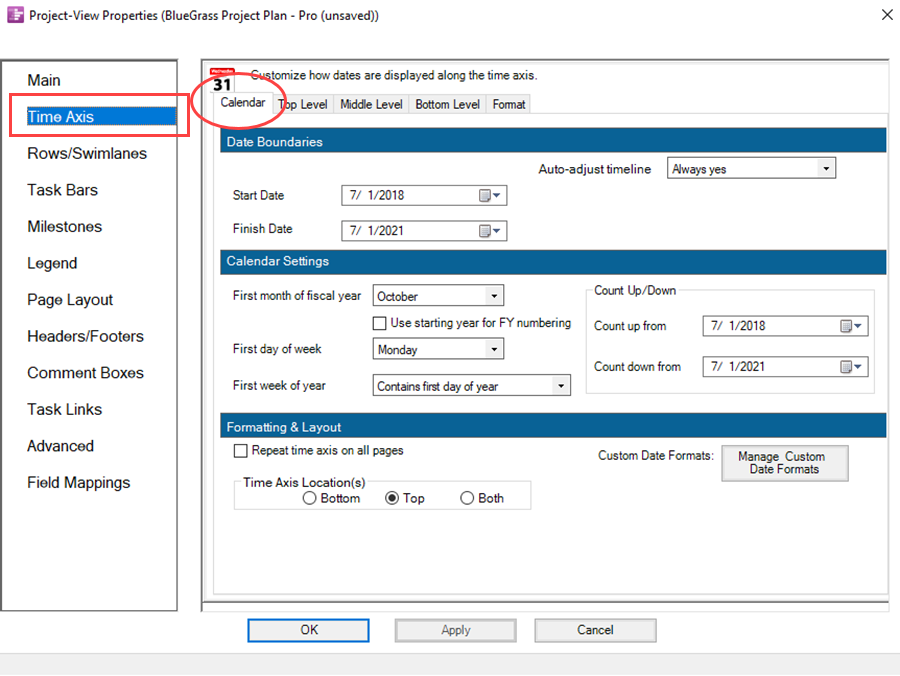
Middle Level Sub-Tab
6) The Middle Level Sub-Tab, which is typical of the three such sub-tabs, looks like this:
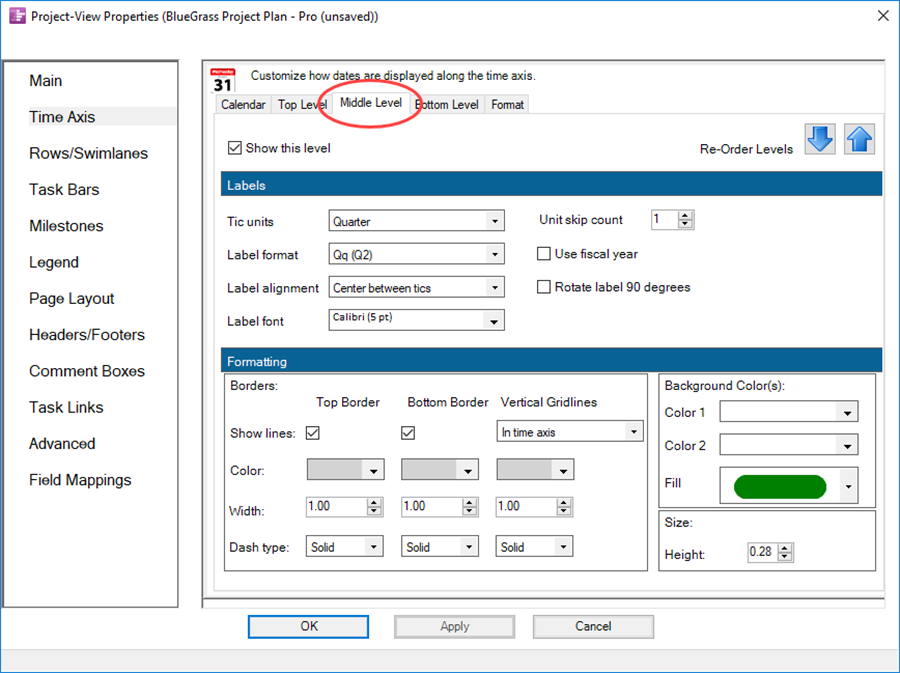
Format Sub-Tab
7) The Format Sub-Tab looks like this:
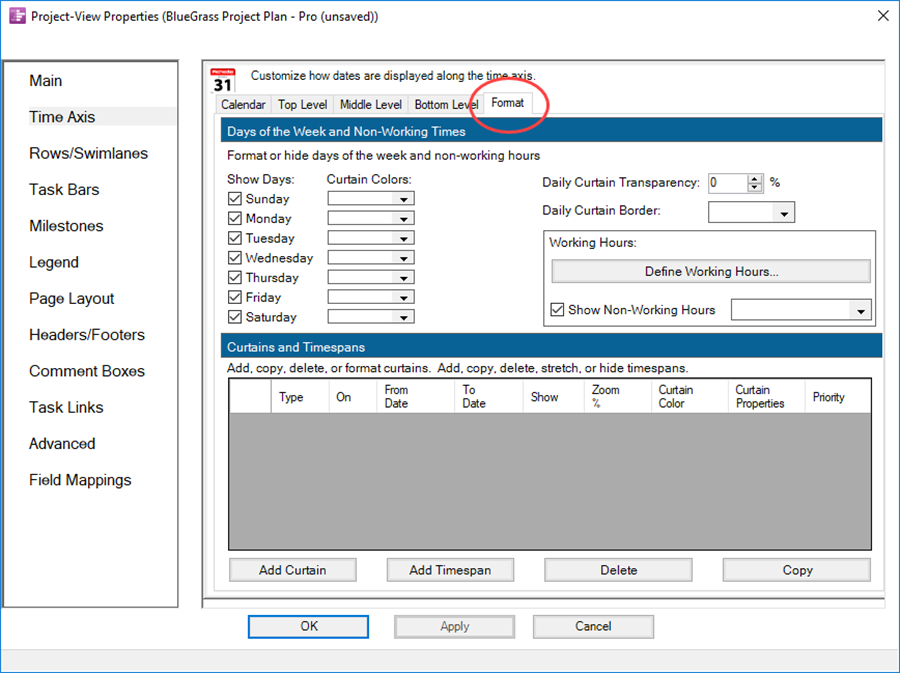
The Reorganized Template and Project-View Properties Main Tab
8) Since the reorganized Template and PVP form’s Main tabs are almost identical, the reorganized PVP form’s Main tab is used in the illustration below:
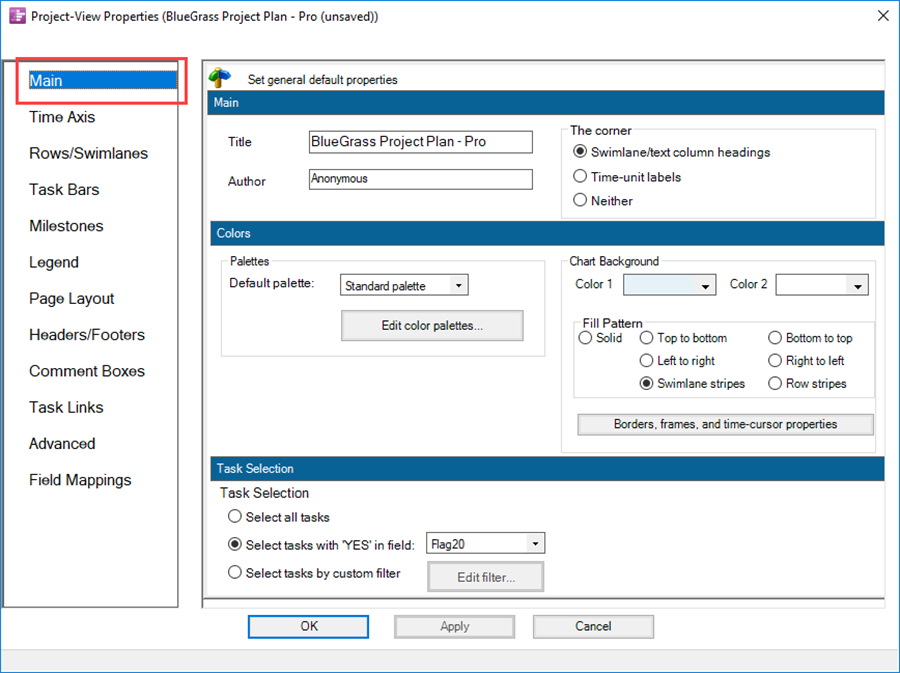
The Reorganized Template and Project-View Properties Advanced Tab
9) Since the updated Template and PVP form’s Advanced tabs are almost identical, the reorganized PVP form’s Advanced tab is used in the illustration below:
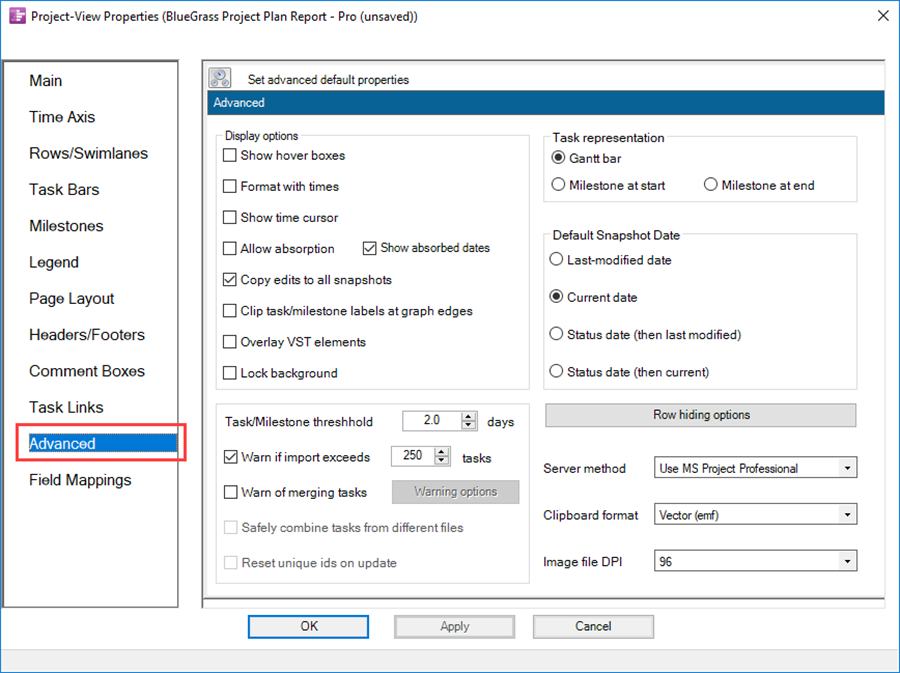
Globally Editing Project View Time Axis Levels and Cells
10) Global edits are made in the Template form for all project views created with that Template. Project views can be edited with the Project-View Properties (PVP) form for all editable graphic elements. The examples that follow can be made in either form but most use the PVP form.
11) Below is a sample project view showing some edits in the three Time Axes for level height, cell text color, background colors, and fill patterns:

Editing the Project View’s Start/Finish Date Boundaries
12) In previous OnePager versions setting the Start/Finish Date boundaries for the project view was in the PVP form’s Main tab. These controls are now consolidated in the PVP form’s new Time Axis tab at the Calendar sub-tab as shown here:
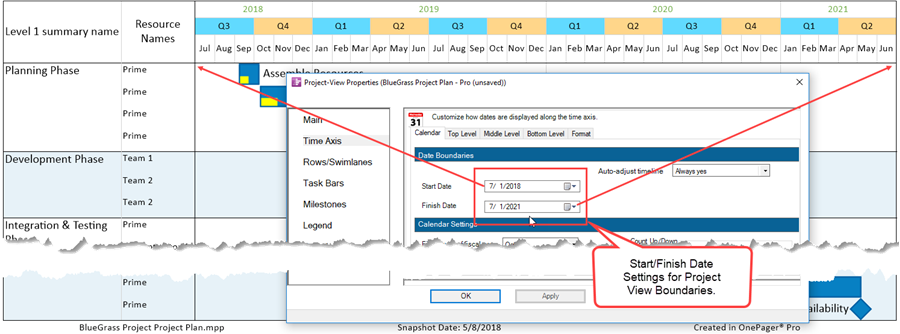
- a) The Start Date and Finish Date boundaries can be edited by accessing the Date Picker dropdown as shown below:
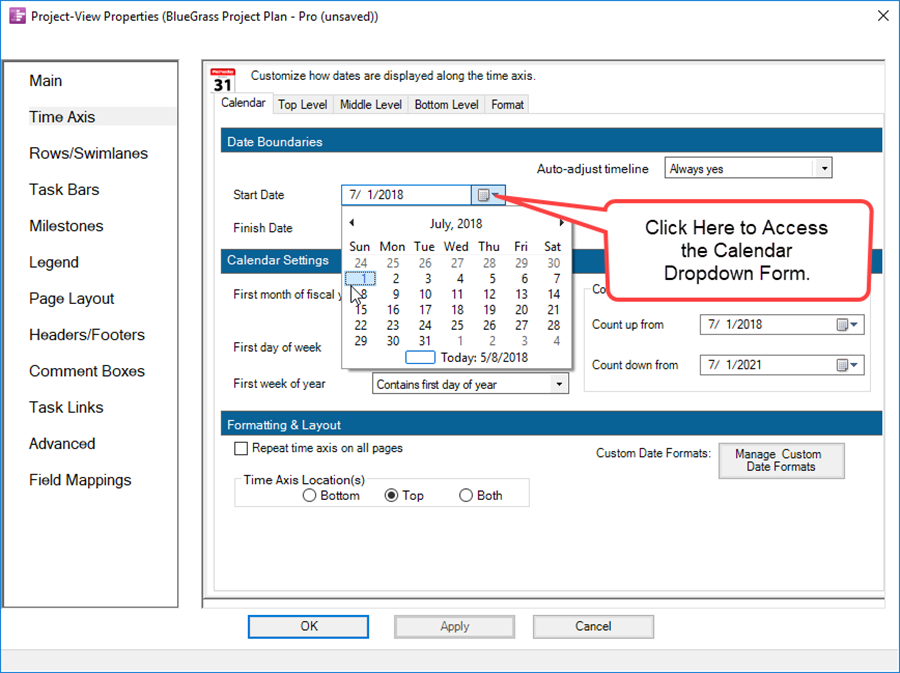
- b) Making edits to the Start Date and/or Finish Date boundaries resets the Date Boundaries for the project view.
- c) Another way to edit the project view’s Date Boundaries is to use the Start and Finish Date Calendars now available on the OnePager 6.1 ribbon’s View tab in the Dates group as shown here:

Showing and Hiding Time Axis Levels and Cells
13) Time Axis Level Cells and Floating Time Axis Level Cells can be hidden to create timespan gaps in the timeline. The following example shows the creation of such a timespan gap:
- a) Below is the original Time Axis with all Cells shown:

- b) You can manually select the months of September through November of 2019 (with a CTL+Left-Click) and hide the cells by a right-click on a selected Cell to get to the context menu and the Hide cell command as shown below:

- c) Clicking the Hide cell command results in the project view looking like this:

- d) As the illustration above shows, a three month timespan is hidden in the gap. OnePager 6.1 retains a record of this in the table found in the PVP form Time Axis tab Format sub-tab’s Curtains and Timespans control group as shown below:
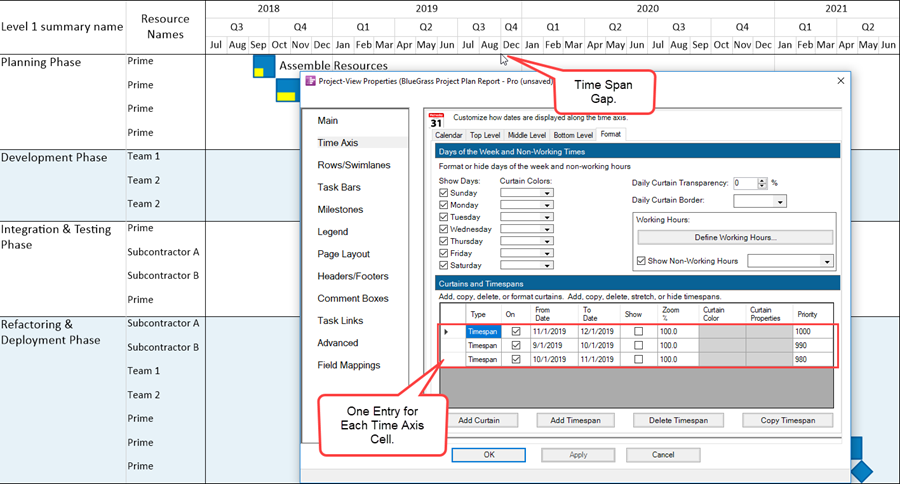
- e) If, in the course of hiding Time Axis Level Cells, tasks/milestones become hidden, entries are made in the Where’s My Stuff!? form as shown in the sequence below:
- i) Select two Quarterly Time Axis Level Cells to be hidden as shown below:
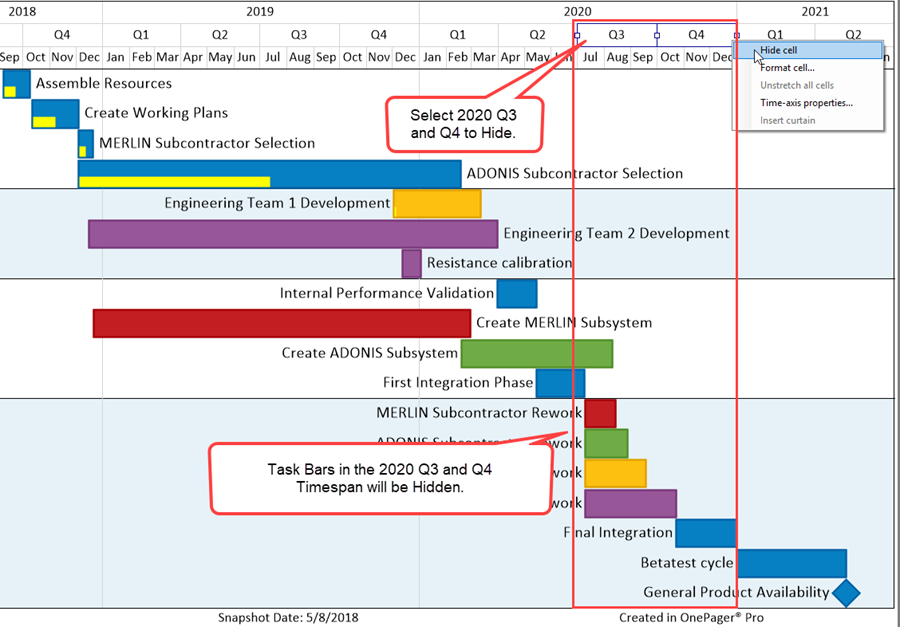
- ii) After hiding the two Quarterly Time Axis Level Cells the project view looks like this in the Where’s My Stuff!? form:
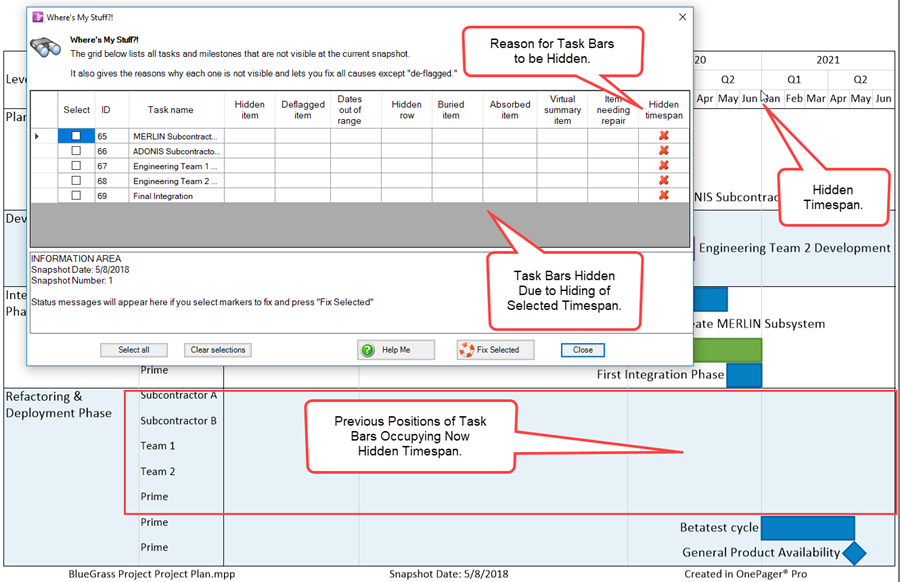
- iv) Clicking the Fix Selected button updates the Where’s My Stuff!? form to look like this:
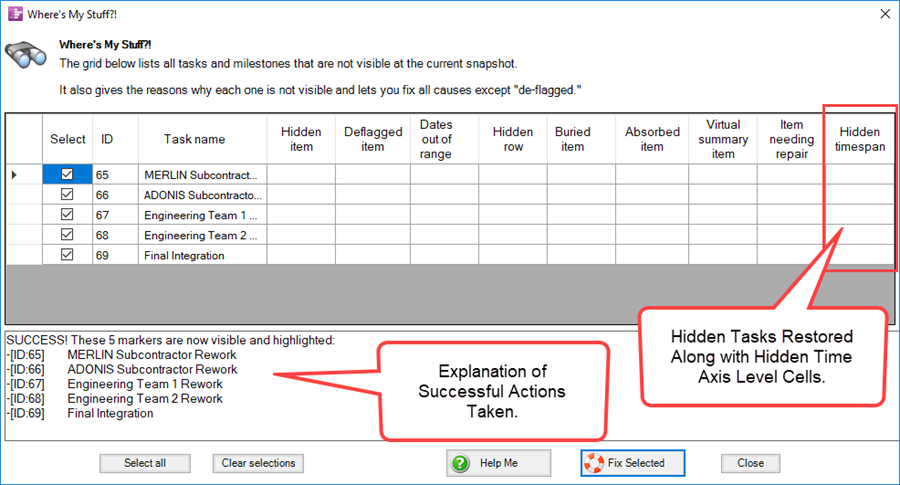
- v) The action restores the five selected tasks to visibility along with their associated Quarterly Time Axis Level Cells as shown below:
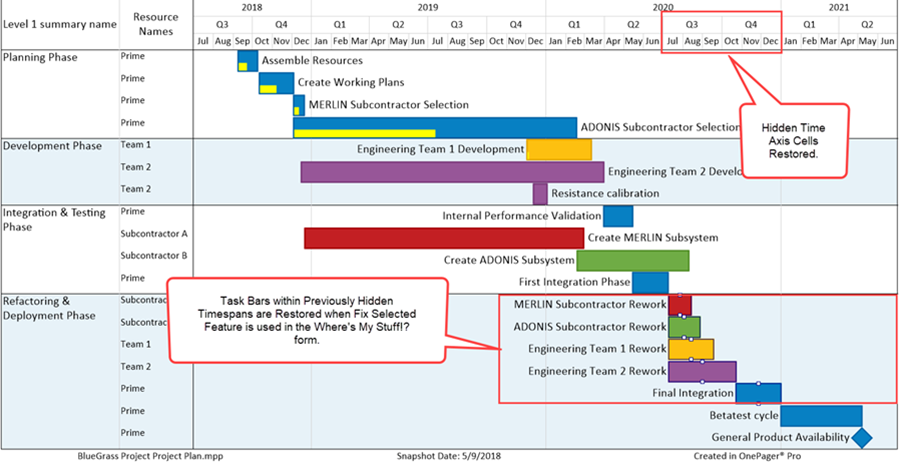
- vi) For more information on the Where’s My Stuff!? form, see the article at: Managing Hidden Tasks and Milestones Using "Where's My Stuff?!".
- f) Hidden Time Axis Level Cells can be restored by using the controls on the OnePager 6.1 ribbon Home tab’s Show/Hide dropdown menu by clicking the Show All Time Axis Cells command as seen here:
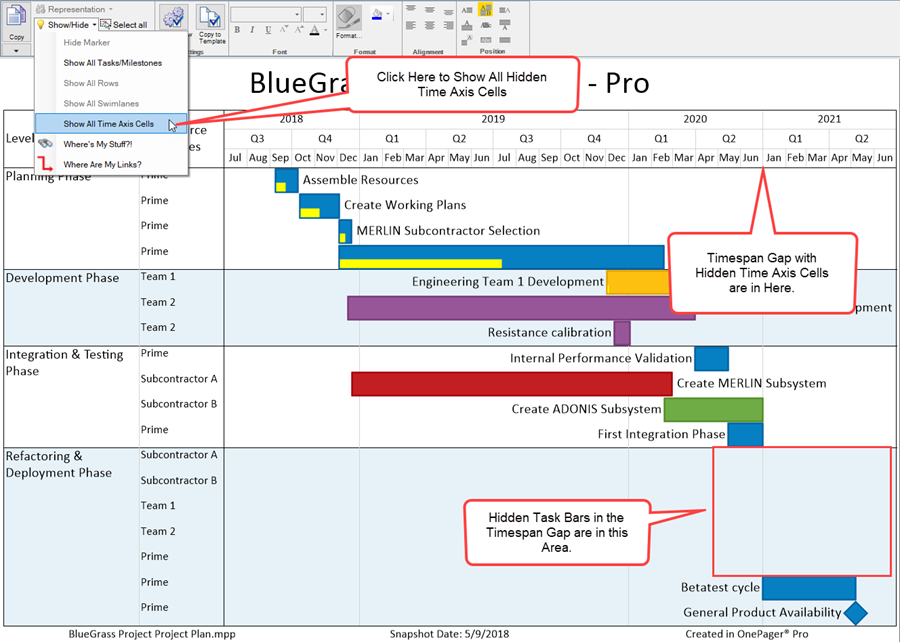
- g) After clicking the Show All Time Axis Cells command, the five hidden month Time Axis Level Cells become shown.
14) The dates used in the The Grid to define the hidden timespan include not only the date for From/To Dates but the time of day as well.
- a) If you just specify dates, OnePager 6.1 assumes that the From Date starts at midnight on that day and the To Date ends a minute before midnight on that day.
- b) To completely specify the timespan for a hidden Time Axis Level Cell it is important to make sure that the timespan is complete.
- c) As an example, to hide the month of January 2019, the From Date should be 1/1/2019 and the To Date should be 2/1/2019 as shown here:
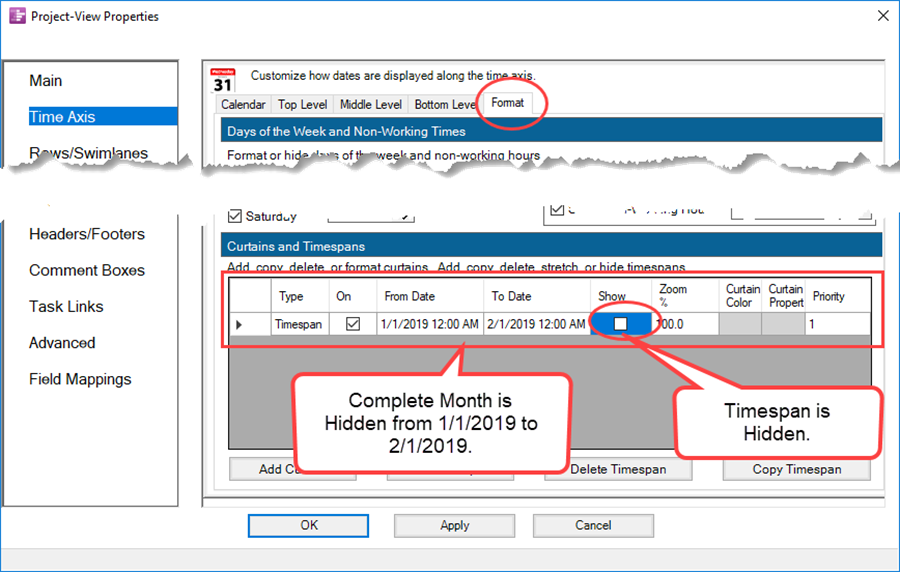
15) Hiding Time Axis Level Cells overrides all other settings that you specify by way of Flagging tasks for import or any specified Conditional Import rules you defined. Although the import takes place, hidden Time Axis Level Cells govern what is shown after import.
Re-ordering Time Axis Levels
16) In addition to being able to now easily hide Time Axis Levels Cells, you can also Re-order Time Axis Level positions. The following example illustrates this:
- a) Given the project view below where the Top, Middle, and Bottom Time Axis Levels in Year, Quarter, and Month are ordered from top to bottom, you can Re-order the Middle Level to the Top Level by clicking the up arrow in the Re-Order Levels control group:
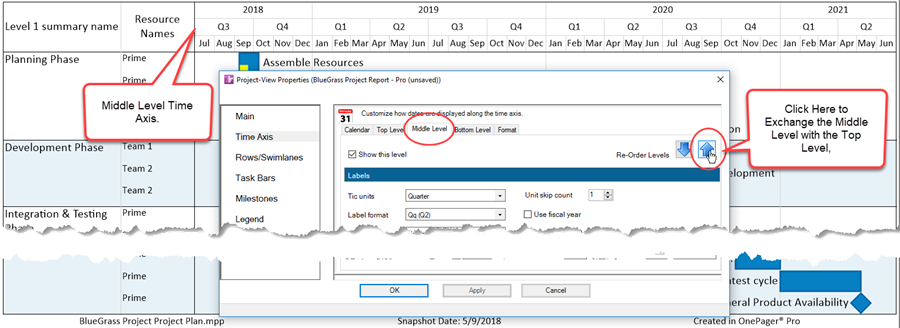
- b) When you click the Apply or OK button in the PVP form the Top and Middle Levels are Re-ordered as shown here:
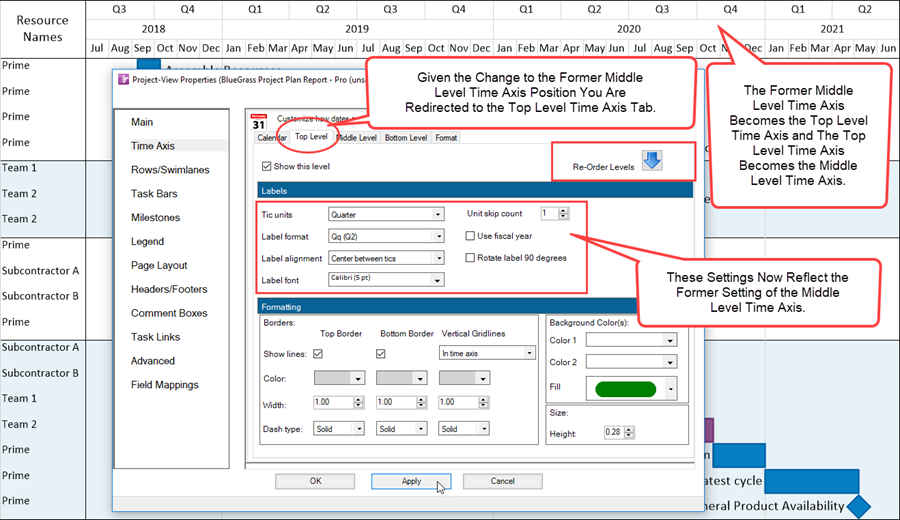
Saving Time Axis Level Cell Settings in the Template Form
17) OnePager 6.1 allows you to save the settings for a project view as a new Template with a Template name of your choosing.
- a) This can be done any time after creating or editing a project view by clicking the Copy to Template button on the OnePager Pro or Express 6.1 ribbon’s Home tab as shown below:

- b) For more information on the Copy to Template function, please see the article at: Managing the Current Template.
18) If your project view contains hidden Time Axis Level Cells, these settings are copied to the new Template form and saved.
19) When the Template form you previously saved is used to create a NEW project view, that project view reflects the hidden Time Axis Level Cells you previously created.
- a) In the saved Template form, the hidden Time Axis Level Cells are represented in the The Grid as shown in the example below:
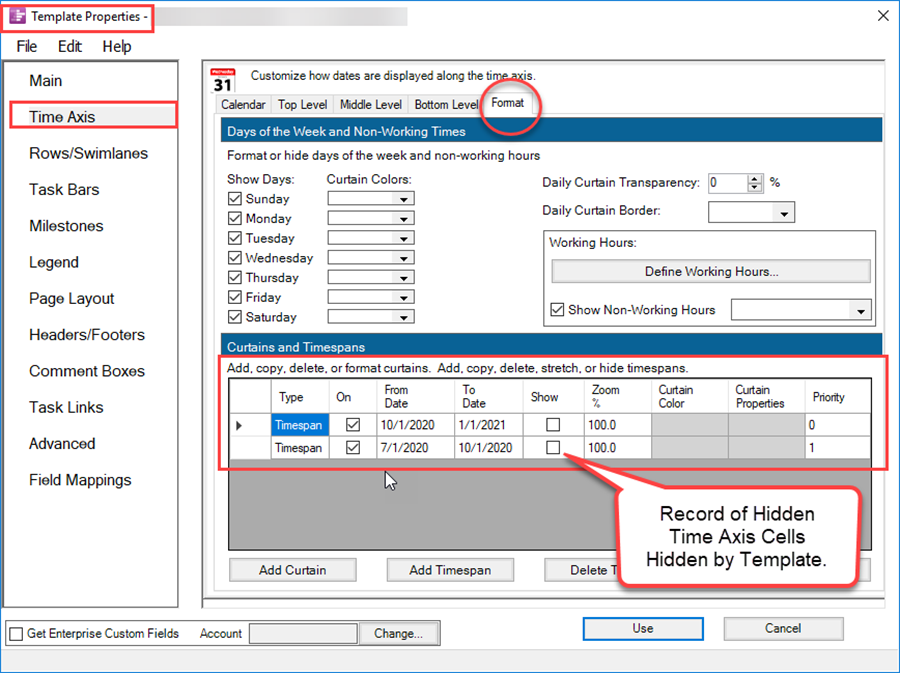
- b) When the above Template form is again used, any Time Axis Level Cells that are between the From Date and To Date are treated as hidden Time Axis Level Cells.
- c) You can also edit the Zoom% value in a project view that is copied to become a new Template. When the saved Template is used again to create a project view, these saved Zoom% values are used on the new project view’s Time Axis Levels.
- d) Subsequent editing any of the corresponding settings in the PVP form’s Time Axis tab’s Format sub-tab does not change the corresponding settings in the Template form.
- e) Settings can be edited in the Template form but the form must be re-saved so that the edited settings are available for subsequent use the next time this Template form is used to represent Hidden Time Axis Level Cells.
The New Non-Linear Time Axis Feature
20) Below is an example of creating a Non-Linear Time Axis representation in the project view in the Bottom Level Time Axis.
- a) First the original Bottom Level Time Axis representation with the Cell to be stretched selected with a left-click is shown here:
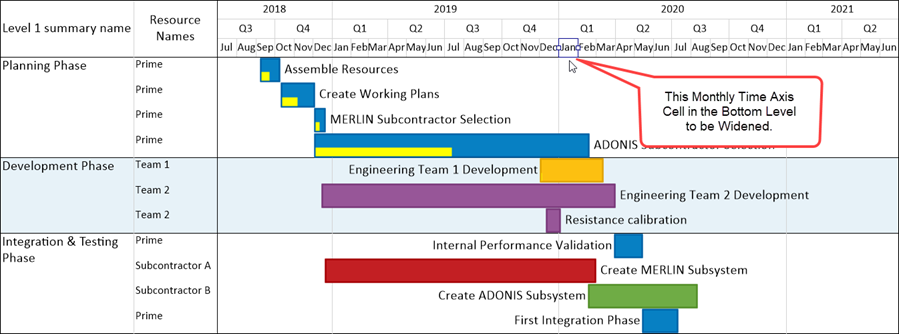
<1--center><P61-0_4_1_9-61-(6)-05082018.png></center-->
- b) After stretching the January 2020 Time Axis Level Cell to the right with a drag and drop action, the project view looks like this:
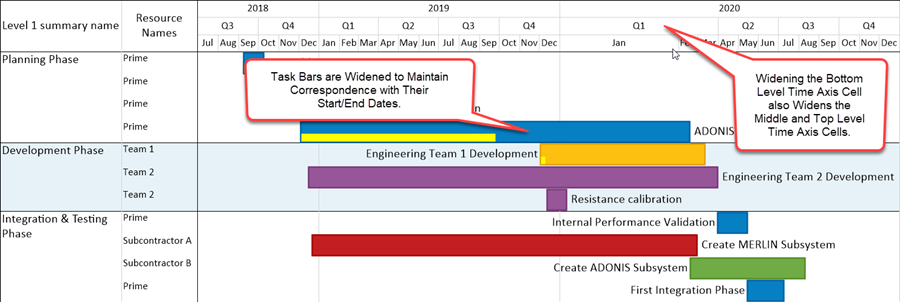
- c) Note that the stretching of the bottom level Time Axis is accompanied by a stretching of the Middle Level and Top Level as shown in the example above.
d) Additionally, any task/milestones within the timespan stretched also appear to be stretched, but their Start/End Dates are not changed.
21) You can select multiple Time Axis Level Cells using the CTL+Left-Click method in a single or in multiple Time Axis Levels.
- a) Selecting a single Time Axis Level Cell in any Time Axis Level allows you to further right-click on the selected Cell, access the Time Axis Level’s context menu, and use any of the commands in the context menu as shown below:

- b) Selecting multiple Time Axis Level Cells in any Time Axis Level and right-clicking on any selected Cells also accesses the context menu where most of the context menu’s command can be used.
22) Selecting multiple Time Axis Level Cells in different Time Axis Levels with the intent of stretching all the selected Cells is not supported.
- a) If this is attempted, OnePager 6.1 only stretches those selected Time Axis Level Cells in the Time Axis Level where you used the mouse to stretch one of the selected Cells.
- b) Time Axis Level Cells in other Time Axis Levels are de-selected before the stretch drag and drop operation is started.
The New Floating Time Axis Feature
23) Below is a sample of an inserted Floating Time Axis:
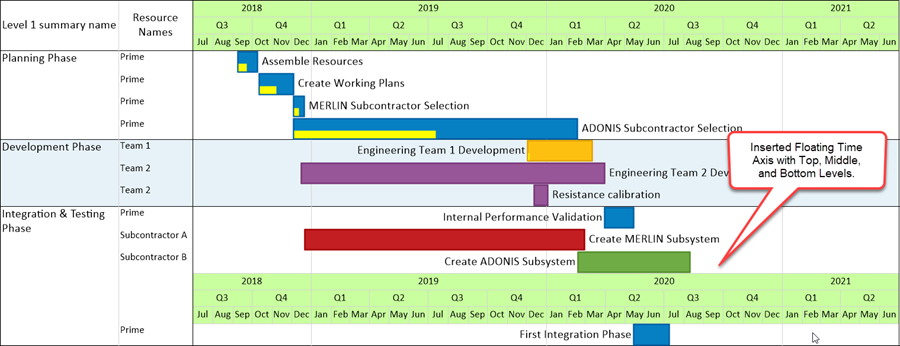
- a) Creating a Floating Time Axis is done by right-clicking in any Row to access the context menu where you want the Floating Time Axis Level to appear either ABOVE or BELOW the selected Row as shown here:
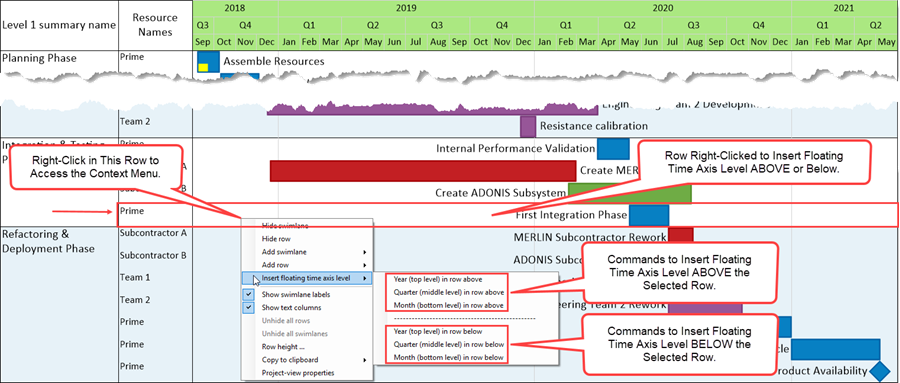
- b) If you click the Insert floating time axis level sub-command to place the Top Level Time Axis ABOVE the selected row, the project view looks like this:
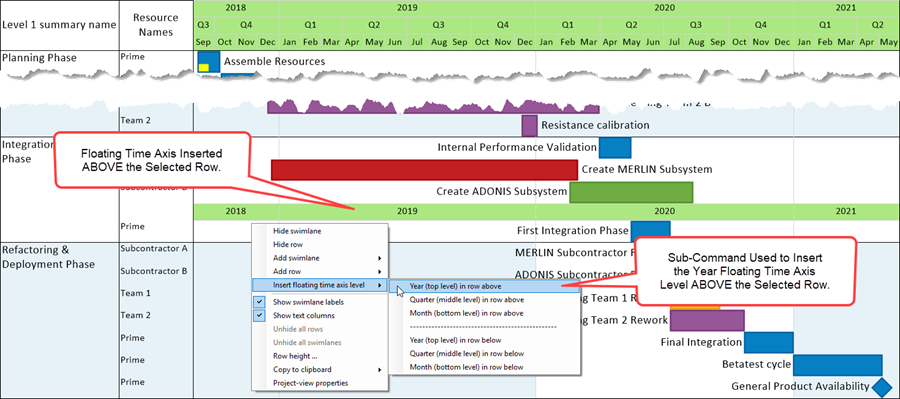
- c) Repeating the process for Inserting the Middle Level Floating Time Axis ABOVE the selected Row creates two levels shown below:
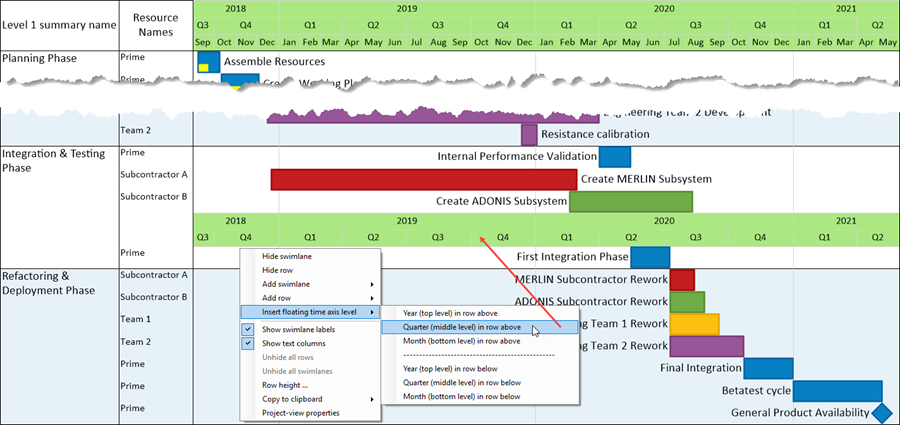
- d) When the repeated action above is completed, all three levels of the Floating Time Axis appear.
- e) The same procedure can be used to Insert Floating Time Axis Levels BELOW the selected Row by accessing the context menu in the desired Row and using the alternate set of sub-commands that place Floating Time Axis Levels BELOW the selected Row.
- f) Several individual or sets of Floating Time Axis Levels can be inserted in the Graph.
24) If you are not sure which Time Axis Level was inserted as a Floating Time Axis, you can always do the following to double-check:
- a) Right-click on any Time Axis Level Cell in the Floating Time Axis in question which accesses the context menu.
- b) Then click the Project-view properties command as shown in the above illustration.
- c) When you do this, the PVP form Time Axis tab is accessed at the Time Axis Level sub-tab belonging to the Floating Time Axis Level you originally right-clicked.
25) Any manual edits made to a Time Axis Level Cell is reflected in the corresponding Floating Time Axis Level Cell with respect to the Cell’s format properties that can be edited in the PVP form Time Axis tab’s three Level sub-tab property setting controls or using the right-click context menu’s Format cell… command.
26) Manual edits made to a Time Axis Level such as editing its height in the PVP form Time Axis Level tabs are not made to the corresponding Floating Time Axis Level.
- a) To edit the height of a Time Axis Level, use the Size sub-group control in the Formatting sub-group controls of the desired PVP form’s Level sub-tabs.
- b) To edit the height of a Floating Time Axis Level, right-click in the desired Floating Time Axis Level’s Row Label, click the context menu’s Row height … command to access the Row height form, and use the controls to edit the row height setting.
- c) Floating Time Axis Levels can differ in height from each other and from Time Axis Levels to meet your visualization needs.
27) Performing edits on the Row in which a Floating Time Axis Level resides either by using the Row’s context menu commands or the Edit Row properties form does not make corresponding edits to the properties of the corresponding Time Axis Level.
28) Only format property edits to individual or multiple Time Axis Level Cells are mirrored in their corresponding Floating Time Axis Level Cells and vice versa.
Enhanced Manual Editing of Timespans (Time Axis Level Cells)
29) By right-clicking on a Time Axis Level Cell it can be edited by using the commands in the context menu as shown here:

30) Right-click in the text label column of a Floating Time Axis Level to edit the Row occupied by a Floating Time Axis Level using the commands in the context menu as shown below:

31) Right-clicking in a Floating Time Axis Level Cell selects the Cell and accesses the context menu to edit the Cell as shown below:

The New Custom Date Format Feature
32) The Top Level Time Axis shown below has a Custom Date Format:
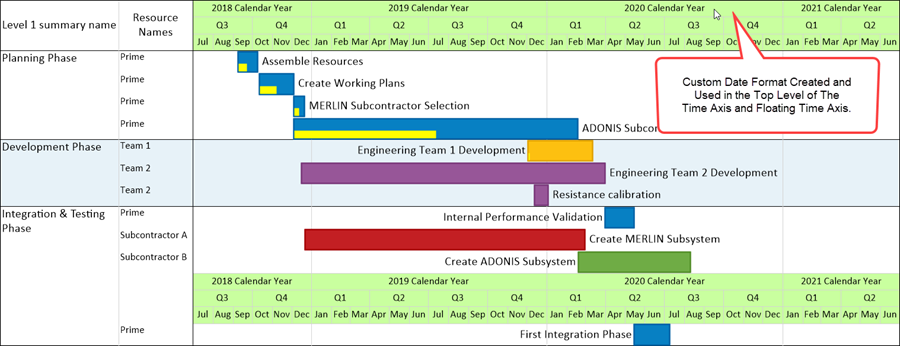
- a) This new feature allows you to create and edit your own Date Formats which then become available in the dropdown lists of all Format date dropdown lists in OnePager Pro and Express 6.1.
- b) See the articles on Custom Date Formats at: The Custom Date Format Feature for OnePager Pro or The Custom Date Format Feature for OnePager Express.
Managing Working Hours and Non-Working Hours
33) There are cases where schedules are created down to the day or hour levels. OnePager 6.1 supports the creation and editing of Daily Curtains so that you can graphically highlight days of the week.
34) Additionally, there are controls for defining Working Hours and Non-Working Hours and applying color to these timespans in the Graph.
35) These controls for managing Daily Curtains and Working Hours/Non-Working Hours are in the PVP form Time Axis tab’s Format sub-tab and look like this:
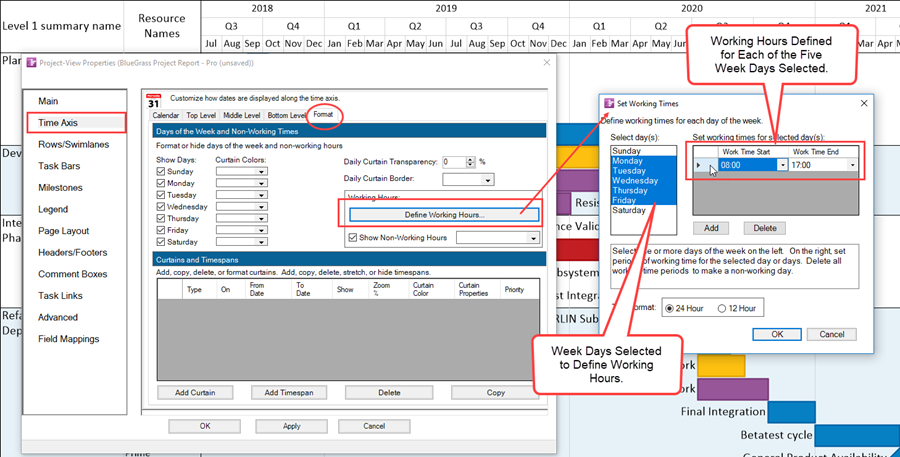
36) In the illustration above, Monday through Friday are defined as having Working Times in the Set Working Times form starting at 0800 hours and ending at 1700 hours. Times may also be expressed in 12 hour format.
37) Using these settings as an example of highlighting Non-Working Hours, if you create a project view that is two weeks in duration it can look something like this:

- a) Since the Show Non-Working Hours checkbox is checked in the PVP form Time Axis tab’s Format sub-tab as shown in the illustration above, all that needs to be done to select a color to represent Non-Working Hours using the standard Color Chooser, click Apply or OK in the PVP form, and the resulting project view appears as shown below:
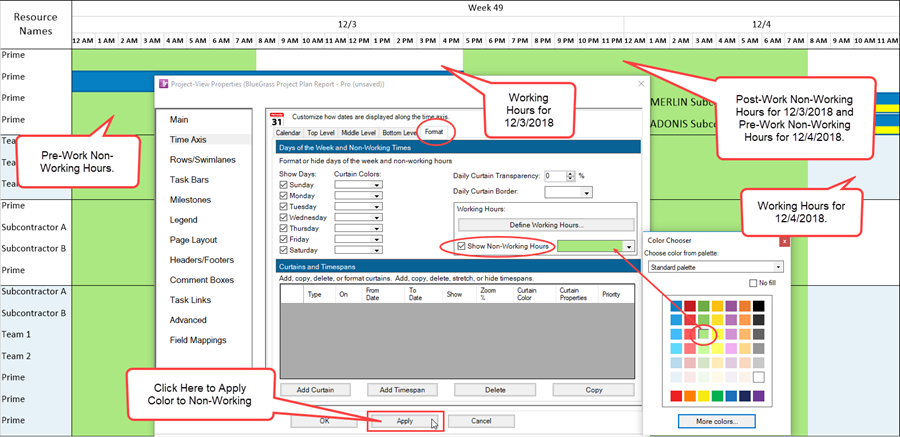
- b) To clear the Non-Working Hours color from the project view, click on the Color Chooser dropdown as shown above and click on the No Fill checkbox in the Color Chooser form. Then click the Apply or OK button in the PVP form. Doing so clears the color, closes the Color Chooser form, and applies the edit to the project view.
38) In OnePager Pro and Express 6.1, Monday through Friday are preset with Working Hours defined from 8:00 AM to 5:00 PM each weekday as the default setting from the Template form and in the PVP form. Saturday and Sunday are defined with all hours as Non-Working Hours.
39) Caution: If you uncheck the Show Non-Working Hours checkbox, the project view hides all Non-Working Hours.
- a) Taking this action can cause the project view’s width to contract as hiding Non-Working Hours causes timespans representing days in the Time Axis to be shorter across the entire project view’s timeline.
- b) Rechecking the Show Non-Working Hours checkbox restores all these hidden timespans to the project view from the project view’s Start Date to Finish Date boundaries.
Managing Inserted Curtains
40) In previous version of OnePager Pro and Express Curtains could only be inserted from the OnePager Insert ribbon using the Curtains button which accessed the Curtains Properties form where the desired Curtain’s format properties are established.
41) The Curtains feature in OnePager Pro and Express 6.1 is enhanced to provide an additional way to create and manage Curtains and provide a means edit them.
Inserting and Managing Curtains
42) In addition to being able to insert manual Curtains using the Curtain button on the OnePager 6.1 ribbon’s Insert tab, OnePager Pro and Express version 6.1 adds a new capability to insert Curtains from within the PVP/Template form’s Time Axis tab.
- a) The PVP form Time Axis tab’s Format sub-tab shown below:
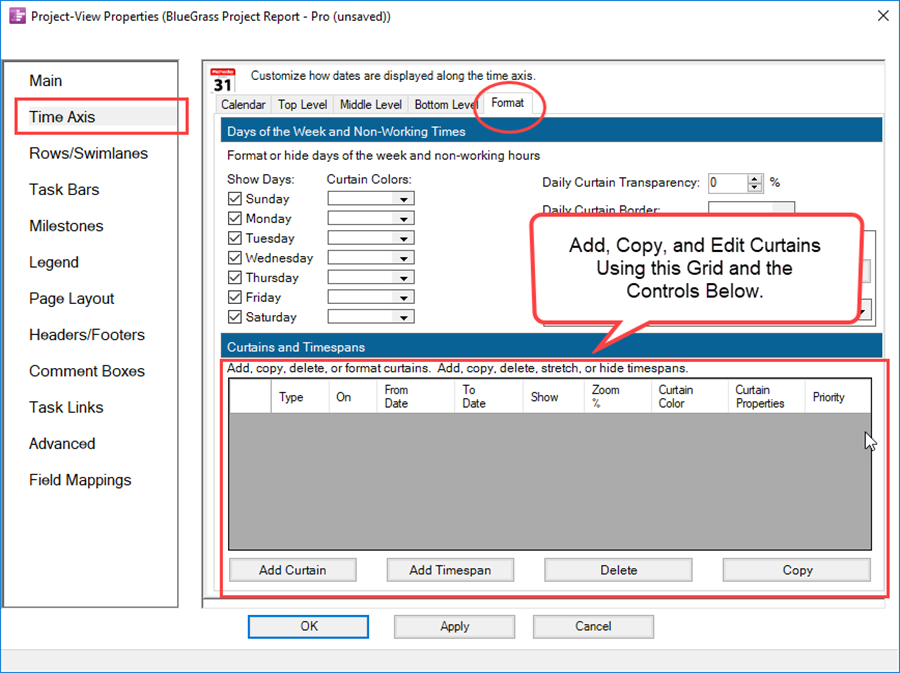
- b) Controls are provided to Add a Curtain, Copy an existing Curtain entry to create another Curtain entry, and to Delete a selected Curtain entry.
- c) You can also edit most Curtain properties with the controls found in the The Grid shown above.
43) A sample Curtain created within the The Grid above looks like this:
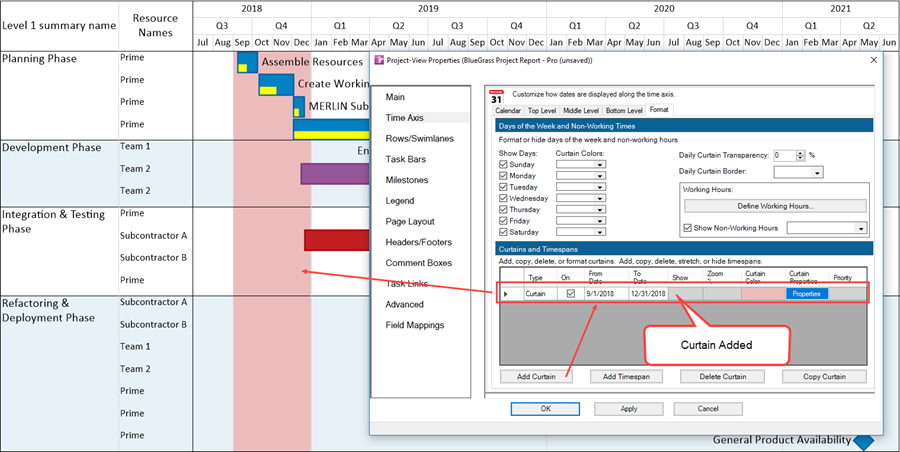
- a) In the entry for the new Curtain, you can click the Properties button and access the Curtain Properties form to edit the Curtain just created as shown here:
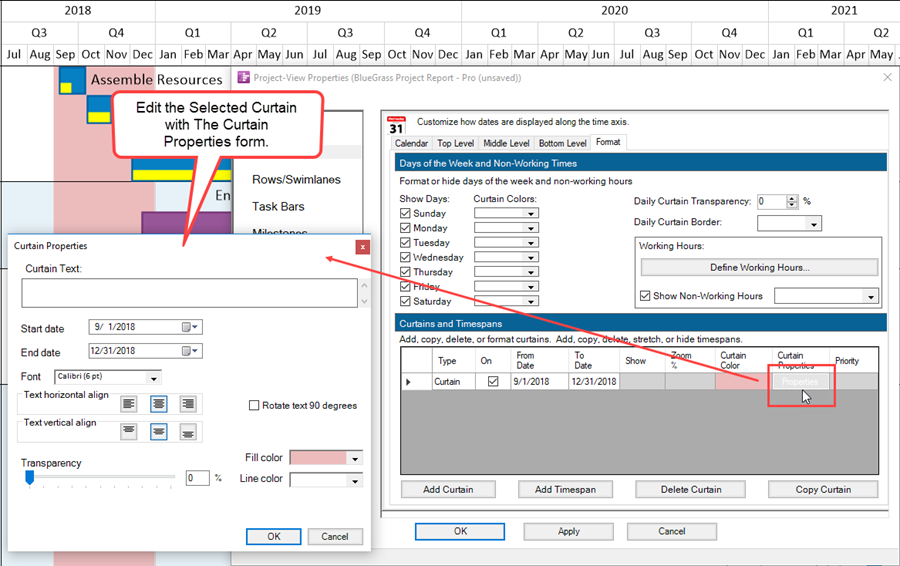
- b) As in previous OnePager Pro and Express versions, Curtains can be edited exactly like a manually inserted Curtain by right-clicking on the Curtain itself to access the Curtain’s context menu:
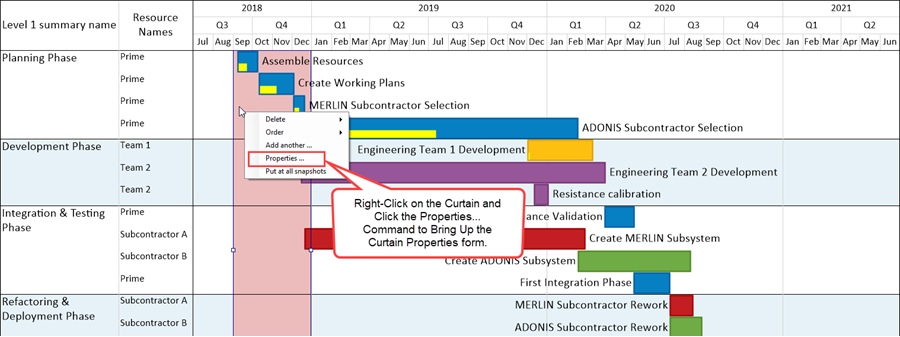
- c) Selecting the Properties… command accesses the standard Curtain Properties form shown here:
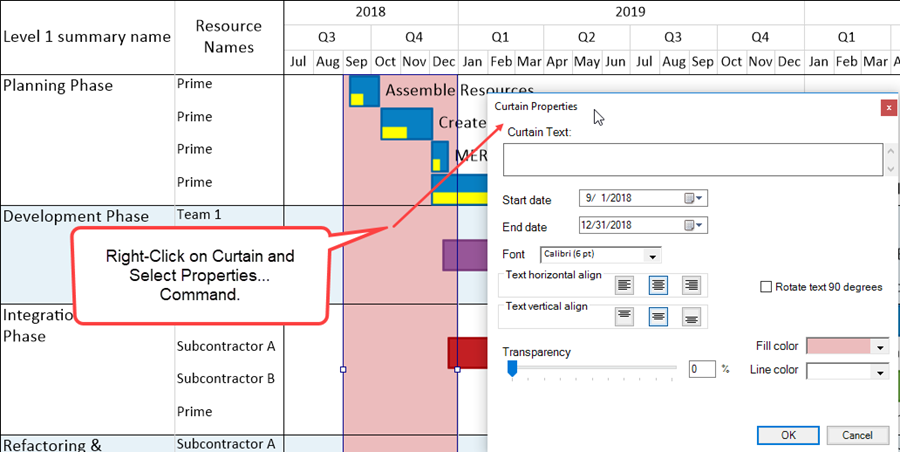
- d) When there are multiple Curtains they are all listed in the The Grid.
- e) Curtains are snapshot-dependent.
- f) For more information on Inserted Curtains, please see the articles at: Creating, Editing, and Managing Time Axis Daily Curtains for OnePager Pro or Creating, Editing, and Managing Time Axis Daily Curtains for OnePager Express.
Creating and Editing Daily Curtains
44) OnePager Pro and Express 6.1 have a new feature called Daily Curtains that allows you to add colored Curtains throughout the project view for specific days of the week.
- a) This new feature is useful when it is important to visualize a particular day or days in a week that have special meaning.
- b) The most common usage is to display Daily Curtains for weekend days.
45) Typically, Daily Curtains are used in project views where the timeline is short, say two weeks or less as shown below:
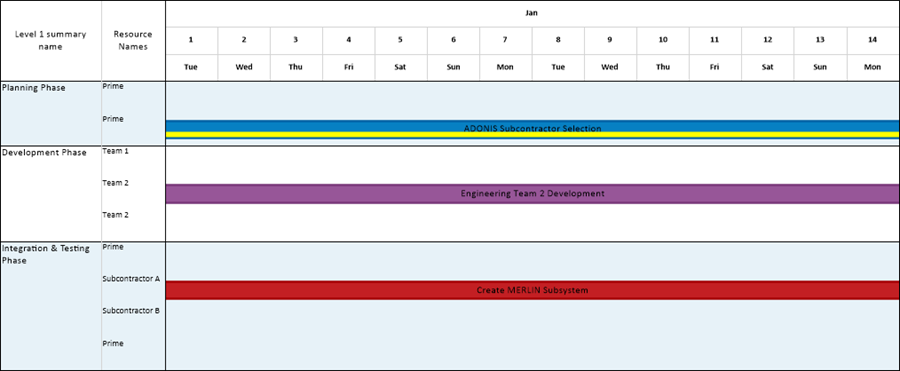
- a) If you go to the PVP form Time Axis tab’s Format sub-tab you can assign different colors to Sunday and Saturday in the Days of the Week and Non-Working Times control group as done below:
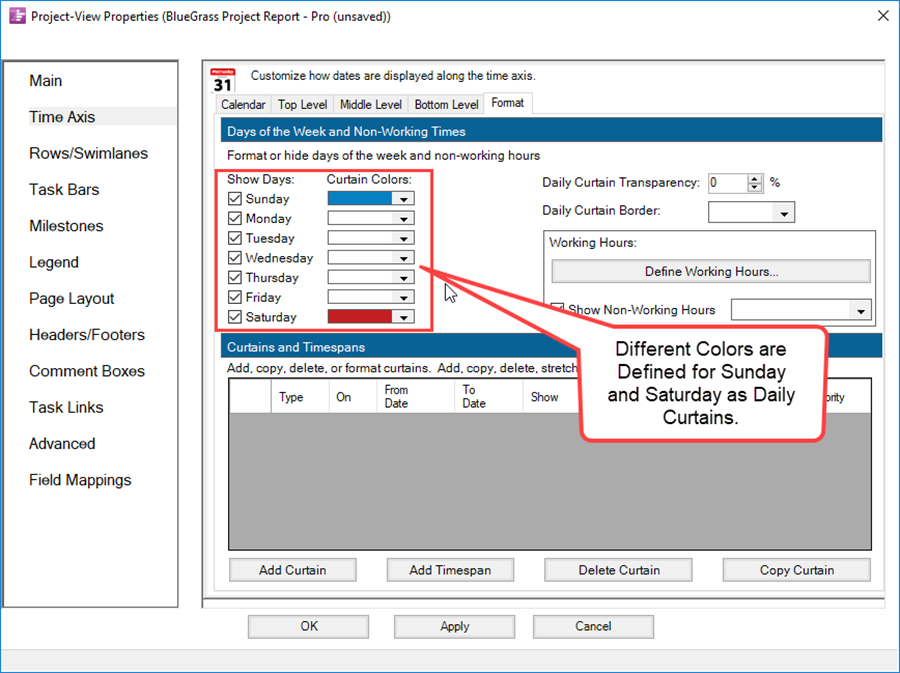
- b) When these settings are Applied to the project view, it looks like this:
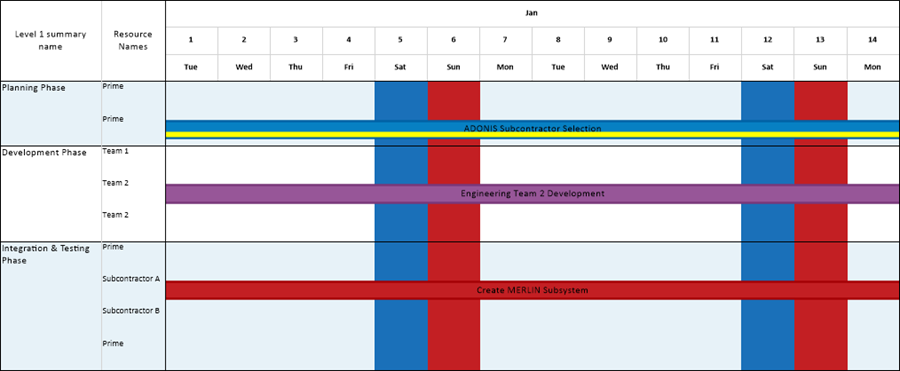
- c) Daily Curtains cannot be manually selected or edited in the project view with a left or right-click. However, the properties of all Daily Curtains as a group can be edited by accessing the PVP form Time Axis tab’s Format sub-tab’s Days of the Week and Non-Working Times control group.
- d) The Transparency percentage (%) and the border color for all Daily Curtains can be set and edited using the Daily Curtain Transparency: and the Daily Curtain Border: controls provided.
- e) Daily Curtains do NOT appear as entries in the The Grid.
- f) Daily Curtains can be eliminated from the project view by editing their color selection in the standard OnePager Color Chooser to No Fill.
- g) Daily Curtains are snapshot-independent, that is, they appear in all snapshots.
Managing Timespans
46) Timespans are created whenever you manually stretch or compress a Time Axis Level Cell or a Floating Time Axis Level Cell.
47) Timespans can be stretched or compressed manually by selecting Time Axis Level Cells (or Floating Time Axis Level Cells) and using the handlebars to edit their widths. Whenever you do this, an entry is made in the The Grid of the PVP form Time Axis tab Format sub-tab.
Managing Timespans from the PVP Form Time Axis Tab’s Format Sub-Tab
48) The The Grid in the Format sub-tab also has the capability to create, and edit Timespans.
- a) As an example, if you manually select a Time Axis Level Cell in the Middle Level and stretch it as shown below, you get the following entry in the The Grid:
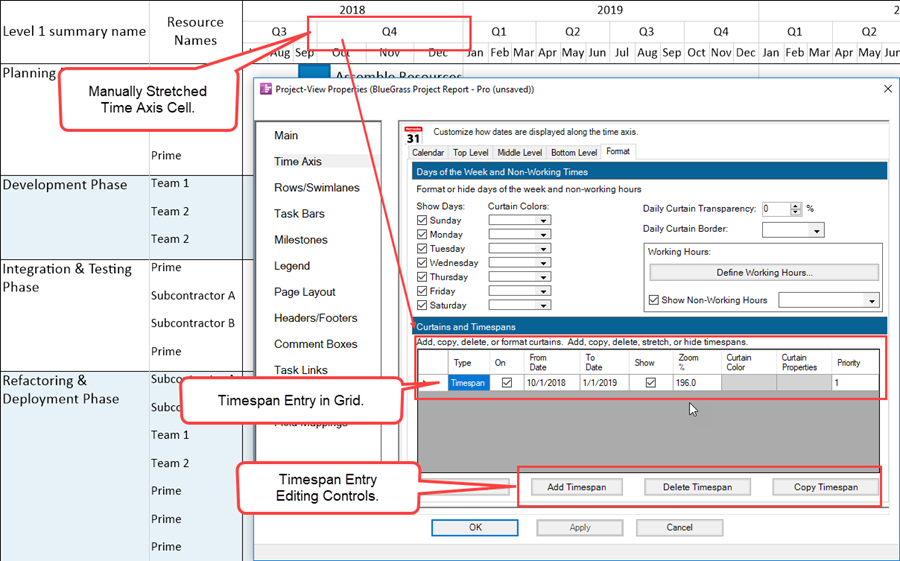
- b) From the The Grid you can turn the entry On or Off, hide or show the selected timespan, edit an entry’s From/To Dates, and edit an entry’s Zoom% (i.e., stretch or compress value).
- c) To clarify, when a The Grid entry is On, the entry is enabled and is considered as an enabled rule that OnePager 6.1 applies to the project view. When a The Grid entry is Off, the entry is disabled and OnePager 6.1 does not apply the rule to the project view.
- d) For The Grid entries that have the On column checkbox checked (enabled) and the entry’s Show column’s checkbox is checked (or On), OnePager 6.1 shows the Curtain in the project view. Conversely, if the entry’s Show column’s checkbox is unchecked (or Off), the Curtain is hidden.
- e) You can also use the Timespan Edit Controls below the The Grid to Add, Delete, or Copy a selected Timespan entry.
- f) Timespans are snapshot-independent.
Managing Timespans with the Time Axis Level Cell Context Menu
49) Time Axis Level Cells can be selected and edited by right-clicking on the Cell and using the context menu as shown below:

- a) The Hide cell command does just that, hides the Time Axis Level Cell and any Cells in lower level Time Axes.
- b) The Format cell… command accesses the Time Axis Cell Properties form shown here:
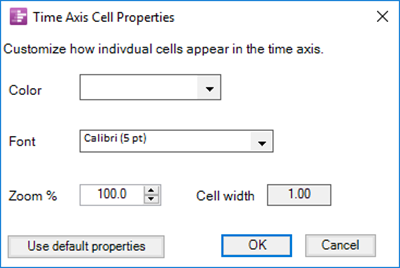
- c) The Unstretch all cells command causes all Cells to revert back to its original width along with all associated Cells in adjacent Time Axis Levels.
- d) The Time-axis properties … command takes you to the PVP form Time Axis tab associated with the Time Axis Level that the selected Cell happens to occupy. From the form you can edit Global Time Axis Properties.
50) The Insert curtain command, when selected, is a convenient way to create a Curtain whose Start/End Dates are the boundaries of the selected Time Axis Level Cell.
- a) As an example, performing these steps creates a basic Curtain with the same Start/End Date boundaries as the selected Time Axis Level Cell as shown below:
- i) Select a Time Axis Level Cell under which you want to insert a Curtain by right-clicking the Cell to access the context menu.
- ii) Click the Insert curtain command at the bottom of the context menu.
- iii) The result of this action is shown in the illustration below:
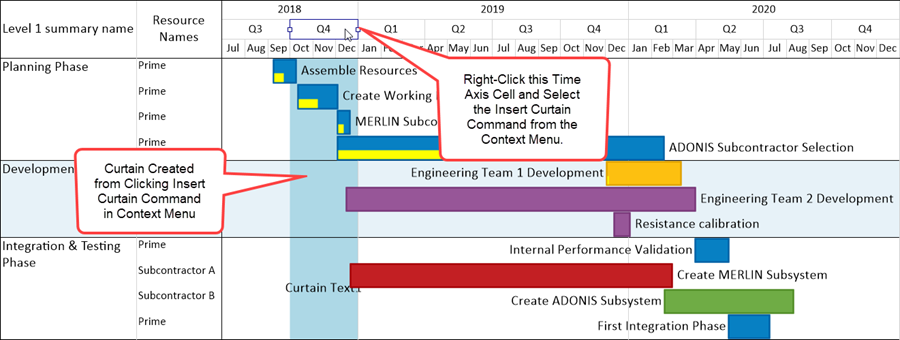
- b) If you access the PVP form and go to the Time Axis tab and its Format sub-tab you’ll find an entry in the The Grid for the Curtain as shown below:
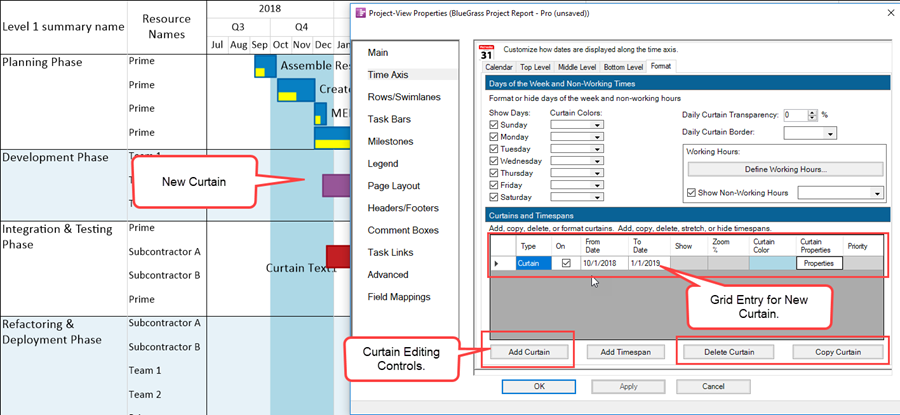
- c) As with Timespans in the The Grid, you have controls for turning the Curtain On and Off, editing the Curtain’s From/To Dates, editing the Curtain’s color, and accessing Curtain Properties form as shown below:
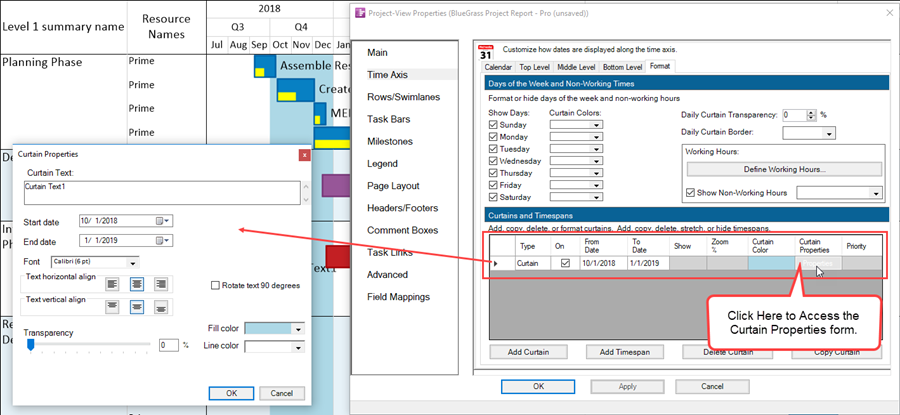
- d) You can also use the Curtain Edit Controls below the The Grid to Add, Delete, or Copy a selected Curtain entry.
- e) Right-clicking on the Curtain itself accesses the same context menu that is associated with all Curtains.
- f) Curtains inserted by using the Time Axis Level Cell’s context menu are snapshot-dependent.
Curtains, Timespans, and Snapshots
51) All Curtains created by whatever means by OnePager 6.1 can appear in all snapshots of the project view with the exceptions noted below.
52) Non-Linear Time Axis Level Cells, those that are stretched or compressed, always appear in all snapshots of a project view.
53) Daily Curtains and Non-Working Hour Curtains are all snapshot-independent. That is, these Curtain types always appear in all snapshots and any edit to them in the project view are applied to all snapshots.
54) Curtains inserted manually by right-clicking a Time Axis Level Cell(s) and Curtains created by Adding a Curtain as an entry in the The Grid are snapshot-dependent. These Curtains can appear in all snapshots, or can be turned ON or OFF for each individual snapshot manually.
55) Curtains that are inserted by using the Curtain button on the OnePager 6.1 ribbon’s Insert tab are snapshot-dependent. These legacy Curtains can look different through editing in any snapshot.
56) It is a rule that Non-Linear Time Axis Level Cells are also snapshot-independent regardless if they are created by manual drag and drop techniques applied to the Time Axis or if they are created as a Timespans entry in the The Grid.
57) The OnePager rules that apply to snapshot-independent and snapshot-dependent objects apply to Curtains and Timespans.
Links to Detailed Articles
OnePager's Time Axis Basic Features for Version 6.1
OnePager's Time Axis Intermediate Features for Version 6.1
Using, Editing, and Managing the OnePager Time Axis for Version 6.1
Editing the Time Axis for Version 6.1
OnePager's Time Axis Advanced Features for Version 6.1
Related Links
Task Links Tab for OnePager Pro
Task Links Tab for OnePager Express
(0.4.1.9-61)